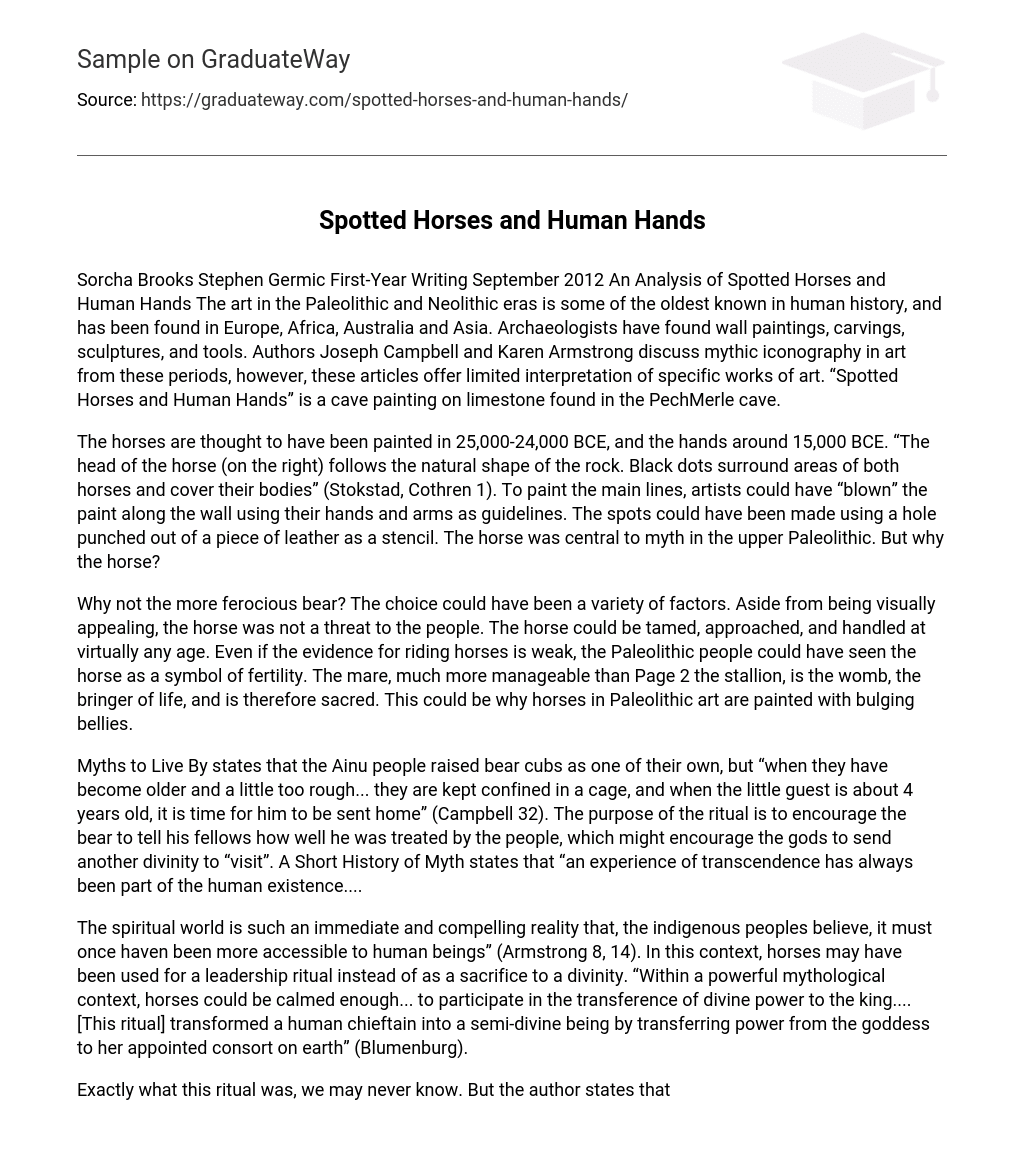The art in the Paleolithic and Neolithic eras is some of the oldest known in human history, and has been found in Europe, Africa, Australia and Asia. Archaeologists have found wall paintings, carvings, sculptures, and tools. Authors Joseph Campbell and Karen Armstrong discuss mythic iconography in art from these periods, however, these articles offer limited interpretation of specific works of art. “Spotted Horses and Human Hands” is a cave painting on limestone found in the Pech Merle cave.
The horses are thought to have been painted in 25,000-24,000 BCE, and the hands around 15,000. “The head of the horse (on the right) follows the natural shape of the rock. Black dots surround areas of both horses and cover their bodies” (Stokstad, Cothren 1). To paint the main lines, artists could have “blown” the paint along the wall using their hands and arms as guidelines. The spots could have been made using a hole punched out of a piece of leather as a stencil. The horse was central to myth in the upper Paleolithic. But why the horse?
Why not the more ferocious bear? The choice could have been a variety of factors. Aside from being visually appealing, the horse was not a threat to the people. The horse could be tamed, approached, and handled at virtually any age. Even if the evidence for riding horses is weak, the Paleolithic people could have seen the horse as a symbol of fertility. The mare, much more manageable than Page 2 the stallion, is the womb, the bringer of life, and is therefore sacred. This could be why horses in Paleolithic art are painted with bulging bellies. Myths to Live By states that the Ainu people raised bear cubs as one of their own, but “when they have become older and a little too rough… they are kept confined in a cage, and when the little guest is about 4 years old, it is time for him to be sent home” (Campbell 32).
The purpose of the ritual is to encourage the bear to tell his fellows how well he was treated by the people, which might encourage the gods to send another divinity to “visit”. A Short History of Myth states that “an experience of transcendence has always been part of the human existence.
The spiritual world is such an immediate and compelling reality that, the indigenous peoples believe, it must once haven been more accessible to human beings” (Armstrong 8, 14). In this context, horses may have been used for a leadership ritual instead of as a sacrifice to a divinity. “Within a powerful mythological context, horses could be calmed enough… to participate in the transference of divine power to the king…. [This ritual] transformed a human chieftain into a semi-divine being by transferring power from the goddess to her appointed consort on earth” (Blumenburg).
Exactly what this ritual was, we may never know. But the author states that the horse was used as a sort of “gateway” to the divine, passing on divinity to who the goddess had chosen to be leader. The horse was obviously more than just a food source to the Paleolithic people. It could have been a connection to the spirit world, offering divinity to the leaders and symbolizing fertility. By keeping the horse nearby (or simply depicting it on cave walls), Paleolithic people could have maintained their close contact with the divine. Spotted Horses and Human Hands. Pech-Merle cave, Dordogne, France. (Stokstad, Cothren)
Works Cited
- Armstrong, Karen. A Short History of Myth. Canongate, 2005. Page 8, 14.
- Print. Blumenburg, Bennet. “The Origins of Mythology in the Upper Paleolithic Cultures of Eurasia. ” Ancient History and Religion Timeline Project. 1994. Web. 10 Sept. 2012.
- Campbell, Joseph. Myths to Live By. Bantam Books, 1988. Page 32. Print.
- Stokstad, Marilyn, and Michael Cothren. Art History: Ancient Art. 4th Edition. Upper Saddle River: Pearson Education, Inc. , 2011. Page 1. Print.





